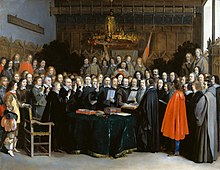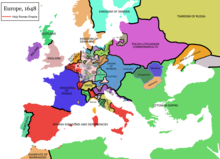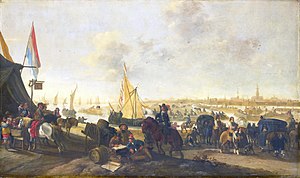Peace of Münster
| History of the Netherlands |
|---|
 |
|
|

The Peace of Münster was a treaty between the Lords States General of the Seven United Netherlands[a] and the Spanish Crown, the terms of which were agreed on 30 January 1648.[1] The treaty, part of the Peace of Westphalia, is a key event in Dutch history, marking the formal recognition of the independent Dutch Republic and the end of the Thirty Years' War and the Eighty Years' War.
Background

The years 1621–1648 constituted the final phase of the Eighty Years' War (c. 1568–1648) between the Spanish Empire and the emerging Dutch Republic. It began when the Twelve Years' Truce (1609–1621) expired, and concluded with the Peace of Münster in 1648.
Although the Dutch and Spanish were both involved in opposite sides of the War of the Jülich Succession (June 1609 – October 1610; May–October 1614) in Jülich-Cleves-Berg, they carefully avoided each other, and thus the hostilities never spread back into the Habsburg Netherlands, and the truce held firm.[2] Nevertheless, attempts to negotiate a definitive peace also failed, and the war resumed as anticipated in 1621.[3] Essentially, it became a side theatre of the wider Thirty Years' War that had already broken out with the Bohemian Revolt in 1618 in eastern parts of the Holy Roman Empire (Bohemia and Austria), pitting Central Europe's Protestant Union against the Catholic League, although the two conflicts never fully merged.[4] With several back and forths – notably, the Spanish conquered Breda in 1625, but the Dutch took it back in 1637[4] – the Dutch Republic was able to conquer the eastern border forts of Oldenzaal (1626) and Groenlo (1627), the major Brabantian city of 's-Hertogenbosch (1629), the fortified cities of Venlo, Roermond and Maastricht along the Meuse (1632), and Sas van Gent (1644) and Hulst (1645) in Zeelandic Flanders.[4]
Nevertheless, peace talks in 1629–1630 came to nothing. More ambitious plans to conquer Brussels in 1632–1633 with the help of anti-Spanish nobility in the Southern Netherlands never came to fruition. Several attempted Northern republican surprises and sieges of Antwerp were parried by the Spanish royal Army of Flanders.[5]
Nor did the Franco-Dutch alliance bring significant changes to the situation on the ground. It began with a disastrous Franco-Dutch invasion of the southern Netherlands in 1635. This in fact made matters worse for the Dutch when French and Dutch troops sacked the city of Tienen, which cost them the sympathies of the southern Netherlands population.[6]
However, French intervention and internal discontent at the costs of the war in the Low Countries led to a change in Spain's 'Netherlands First' policy. Instead Spain focused on suppressing the French-backed Reapers' War in Catalonia.[7] The resulting stalemate and financial troubles, plus Spanish military exhaustion and Dutch desire for formal political recognition, eventually convinced both sides in the mid-1640s to hold peace talks.[5]
The outcome was the 1648 Peace of Münster, which confirmed most agreements already reached with the Truce of 1609.[8]Negotiations

Negotiations between began in 1641 in the towns of Münster and Osnabrück, in present-day Germany. With the initiation of Spanish-Dutch peace talks, Dutch trade with the Levant and the Iberian Peninsula began to flourish. Dutch merchants, benefiting from both the availability of relatively cheap shipping and the cessation of hostilities, soon dominated the markets that had been previously dominated by English traders. Dutch merchants would also benefit from the foreign upheavals of the English Civil War and gain on English trade in their American colonies.[9]
While Spain did not recognise the Dutch Republic, it agreed that the Lords States General of the United Netherlands was 'sovereign' and could participate in the peace talks. In January 1646, eight Dutch representatives arrived in Münster to begin negotiations; these included two delegates from Holland with one each from the other six provinces. The Spanish envoys had been given great authority by the Spanish King Philip IV who had been suing for peace for years.[citation needed]
Start of peace negotiations
The Holland regents continued their attempts at whittling down the stadtholder's influence by breaking up the system of secrete besognes in the States General. This helped wrest influence from the stadtholder's favourites, who dominated these committees. It was an important development in the context of the general peace negotiations which the main participants in the Thirty Years' War (France, Sweden, Spain, the Emperor, and the Republic) started in 1641 in Münster and Osnabrück. The drafting of the instructions for the Dutch delegation occasioned spirited debate and Holland made sure that she was not barred from their formulation. The Dutch demands that were eventually agreed upon were:
- cession by Spain of the entire Meierij district;
- recognition of Dutch conquests in the Indies (both East and West);
- permanent closure of the Scheldt to Antwerp commerce;
- tariff concessions in the Flemish ports; and
- lifting of the Spanish trade embargoes.[10]

Spain's disadvantage
Outcome
On 30 January 1648, the parties reached agreement and the text sent to the Hague and Madrid for approval; it was ratified by the Spanish and Dutch delegations on 15 May, with the States General narrowly approving the Treaty on 5 June 1648.[13]
Despite achieving independence, there was considerable opposition to the Treaty within the States General since it allowed Spain to retain the Southern Provinces and permitted religious toleration for Catholics. Support from the powerful province of Holland meant it was narrowly approved but these differences resulted in political conflict.[13]
Contents
During the peace talks, negotiators representing the Republic and Spain reached an agreement relatively quickly.[8] The text of the Twelve Years' Truce was taken as the foundation, and this made it a lot easier to formulate the peace treaty, because many articles could be copied without too many changes.[8] If one compares the texts of the Twelve Years' Truce of 1609 to the Peace of Münster of 1648, the articles that correspond in whole or in part are as follows::[14]
| Twelve Years' Truce (1609) | Art. 1 | 2 | 3 | 4 | 5 | 6 | 7 | 8 | 9 | 10/11 | 12 | 13 | 14 | 15 | 16 | 17 | 18 | 19 | 20 | 21 | 22 | 23 | 24 | 25 | 26 | 27 | 28 | 29 | 30 | 31 | 32 | 33 | 34 | 36 | 37 | 38 |
| Peace of Münster (1648) | Art. 1 | 2 | 3 | 4 | 5 | 7 | 8 | 17 | 20 | 22 | 23 | 24 | 25 | 31 | 32 | 33 | 34 | 42 | 43 | 46 | 47 | 48 | 51 | 54 | 55 | 56 | 57 | 58 | 59 | 60 | 61 | 62 | 63 | 75 | 77 | 79 |

The States-General of the Dutch Republic were formally recognised by Spain as a sovereign entity. This important concession by Spain was therefore the first point; Spain stopped regarding the Republic's inhabitants as rebellious Spanish subjects (which it had done for 100 years). Peace seemed near. France, with which the Republic had agreed to come to a joint treaty with Spain, threw a spanner in the works by constantly coming up with new demands. The States then decided to conclude a separate peace with Spain without France.[15] On 30 January 1648, the peace text was adopted in four copies, two in French and two in Dutch.[15] The Utrecht delegate Nederhorst initially refused to put down his signature and seal, but after being forced to do so by his province, he put them on 30 April (although they no longer fit neatly on the document).[15] Then the documents were sent to The Hague and Madrid for ratification.[15] On 15 May 1648, the peace was definitively signed and solemnly ratified with an oath by Dutch and Spanish envoys, while a huge crowd was spectating the proceedings from the sidelines.[15]
In the Netherlands, the National Archives in The Hague keeps two copies of the Peace of Münster, a Dutch-language one ("NL-HaNA 1.01.02 12588.55B"), and a Francophone version ("NL-HaNA 1.01.02 12588.55C").[16] Both versions are provided by the Spanish side with French-language ratifications, both signed by King Philip IV – one in Spanish with Yo el Rey ("I the King"), the other in French with Philippe ("Philip") – and both bearing his seal in solid gold.[16][17]: 12–13 They are on display in the archive's exhibition room.[16] The Archivo General de Simancas in Spain preserves the other Dutch-language copy ("ES.47161.AGS//EST,LEG,2943,27") and the other French-language copy ("ES.47161.AGS//EST,LEG,2943,28").[18]
Further developments

See also
Explanatory footnotes
- ^ The Treaty does not use the word Republic but instead recognizes the Lords States General as sovereign.
References
- ^ 1648 Treaty of Munster. Rijks Museum/
- ^ Israel 1995, pp. 407–408.
- ^ "Twaalfjarig Bestand". Encarta Encyclopedie Winkler Prins (in Dutch). Microsoft Corporation/Het Spectrum. 1993–2002.
- ^ a b c Groenveld 2009, p. 25.
- ^ a b Groenveld 2009, p. 26.
- ^ Lesaffer 2006, pp. 2–4.
- ^ Parker, Geoffrey (1972). The Army of Flanders and the Spanish Road 1567–1659: The Logistics of Spanish Victory and Defeat in the Low Countries' Wars (2004 ed.). Cambridge University Press. p. 221. ISBN 978-0521543927.
- ^ a b c Groenveld 2009, p. 142.
- ^ Gijs Rommelse, "The Role of Mercantilism in Anglo-Dutch political relations, 1650–74", p. 596. Economic History Review, New Series, Vol. 63, No. 3 (August 2010), pp. 591–611. JSTOR 40929818.
- ^ Israel 1995, p. 542.
- ^ Israel 1995, pp. 544–556.
- ^ Nolan, Cathal (2017). The Allure of Battle: A History of How Wars Have Been Won and Lost. New York: Oxford University Press. p. 73. ISBN 978-0195383782.
- ^ a b "The Treaty of Münster, 1648" (PDF). University of Massachusetts. Archived from the original (PDF) on 13 July 2019.
- ^ Groenveld 2009, p. 154.
- ^ a b c d e Groenveld 2009, p. 146.
- ^ a b c "Eindelijk vrede (1648)". Nationaal Archief (in Dutch). Retrieved 9 July 2022.
- ^ "Topstukken in perspectief Nationaal Archief". Issuu. 27 March 2019. Retrieved 9 July 2022.
- ^ "EST,LEG,2943,27 - Treaty of peace between Spain and The Netherlands". PARES. Retrieved 9 July 2022.
- ^ Mulder, Doedens & Kortlever 2008, pp. 143–144.
- ^ Runa Hellinga (27 September 2019). "Die eeuw van goud ging aan Brabant en Limburg voorbij". Trouw (in Dutch). Retrieved 15 July 2022.
Bibliography
- Boer, H. W. J. de, H. Bruch en H. Krol (red.) Adriaan Pauw (1585–1653); staatsman en ambachtsheer. Heemstede, VOHB, 1985
- Groenveld, Simon (2009). Unie – Bestand – Vrede. Drie fundamentele wetten van de Republiek der Verenigde Nederlanden. Hilversum: Uitgeverij Verloren. p. 200. ISBN 9789087041274. (in cooperation with H.L.Ph. Leeuwenberg and H.B. van der Weel)
- Manzano Baena, Laura (Winter 2007), "Negotiating Sovereignty: The Peace Treaty of Münster, 1648", History of Political Thought, Volume 28, Number 4, pp. 617–641. JSTOR 26222899.
- Poelhekke, J. J. De vrede van Munster. 's-Gravenhage, Martinus Nijhoff, 1948.
External links
- Scans from the National Archives (The Hague) of the Dutch-language version (12588.55B) of the Peace of Münster
- Scans from the National Archives (The Hague) of the French-language version (12588.55C) of the Peace of Münster
- Printed Latin and German translations of the original text of the Peace of Münster (30 January 1648)
- Tratado de Münster (1648) en español – Modern Spanish version
